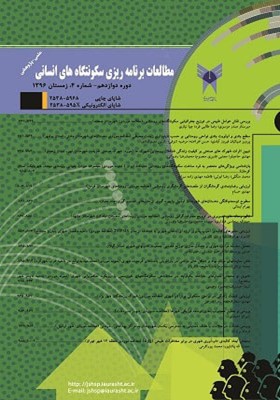رویکرد آیندهنگاری در بازآفرینی محلات فرسوده شهری با تاکید بر مسکن پایدار (مورد مطالعه: محله سرتپوله سنندج)
محورهای موضوعی : مطالعات برنامه ریزی شهری و منطقه ایژیلا سجادی 1 * , حسین ایرجی 2 , پیمان یزدانی راد 3
1 - دانشگاه شهید بهشتی تهران
2 - دانشگاه تهران
3 - دانشگاه علوم تحقیقات
کلید واژه: آیندهپژوهی, بازآفرینی شهری, بافت فرسوده, مسکن پایدار, محله سرتپوله سنندج,
چکیده مقاله :
مقدمه: بافتهای قدیمی شهرها که زمانی از انسجام فضایی و عملکردی مناسب و منسجمی برخوردار بودهاند، اکنون در پی تغییر الگوی زیست و شکلگیری نیازهای جدید دچار نارساییهای کالبدی - فضایی شدیدی گردیدهاند. این تنگناها و تبعات اجتماعی و اقتصادی ناشی از آن، به گونهای دو سویه موجب پایین آمدن کیفیت زندگی در بافتهای قدیمی شهری شده است. یک از راههای مداخله در بافتهای فرسوده شهری بازآفرینی شهری است که به معنای حل معضلات کالبدی – فضایی است که هدف آن ارتقاء اقتصادی، اجتماعی و کالبدی جوامع شهری، بهبود کیفیت زندگی مردم و ارتقاء سیمای شهری میباشد. هدف پژوهش: هدف این پژوهش بازآفرینی محله سرتپوله شهر سنندج با رویکرد آیندهپژوهی برای دستیابی به مسکن پایدار میباشد. روششناسی تحقیق: این پژوهش از لحاظ هدف کاربردی است و با توجه به مؤلفههای مورد بررسی، رویکرد حاکم بر آن روش توصیفی- تحلیلی است. از تکنیک پویش محیطی و دلفی برای شناسایی متغیرها و شاخصها استفاده شده است. قلمرو جغرافیایی پژوهش: در این پژوهش به منظور انتخاب آگاهانهی شرکتکنندگان، از روش نمونهگیری هدفمند استفاده شده است (انتخاب گروهی از خبرگان شهری). با استناد به توضیحات فوق، جامعة آماری این پژوهش 40 تن از کارشناسان خبره در حوزهی مسائل شهری، شامل کارشناسان شهرداری سنندج (مناطق شهری مختلف)، مهندسان مشاور و برخی از اساتید دانشگاهی متخصص در حوزهی مورد مطالعه هستند، سپس دادهها از طریق نرمافزار MICMAC تجزیه و تحلیل شدند. یافتهها و بحث: نتایج حاصل از پراکندگی متغیرها در محور تاثیرگذاری و تاثیرپذیری عوامل، حاکی از ناپایداری سیستم در بازآفرینی محله سرتپوله است. و در نهایت با توجه به امتیاز بالای اثرگذاری مستقیم و غیرمستقیم عوامل، 18 عامل اصلی بعنوان پیشرانهای کلیدی در آیندهی بازآفرینی محله سرتپوله با تأکید بر تأمین مسکن پایدار مورد شناسایی قرار گرفتند. نتیجهگیری: از بین پیشرانهای مورد بررسی، متغیرهای بخش اقتصادی و مالی بیشترین تأثیر را بر تأمین مسکن در زمینهی بازآفرینی محله سرتپوله داشتند.
Introduction: The old textures of cities, which once had a proper and coherent spatial and functional cohesion, have now suffered from severe physical-spatial deficiencies following a change in life pattern and the formation of new needs. These bottlenecks and the resulting social and economic consequences have bilaterally reduced the quality of life in the old urban context. One of the ways to intervene in the worn-out urban contexts is urban regeneration, which means solving physical-spatial problems that aim to improve the economic, social and physical development of urban communities, improve the quality of life of people and improve the urban appearance. Aim of the research: The aim of this research is to recreate the Sartpuleh neighborhood of Sanandaj with a future research approach to achieve sustainable housing. Research Methodology: This research is applied in terms of purpose and according to the studied components, the approach is the descriptive-analytical method. Environmental and Delphi scanning techniques have been used to identify variables and indicators. Geographical scope of the research: In this study, in order to consciously select the participants, the purposeful sampling method has been used (selection of a group of urban experts). Based on the above explanations, the statistical population of this study is 40 experts in the field of urban issues, including experts of Sanandaj Municipality (different urban areas), consulting engineers and some university professors specializing in the field, then the data through MICMAC software were analyzed. Findings and Discussion: The results obtained from the dispersion of variables in the axis of influence and influence of factors indicate the instability of the system in the reconstruction of Sartpooleh neighborhood. Finally, due to the high score of direct and indirect impact of factors, 18 main factors were identified as key drivers in the future of the reconstruction of Sartpuleh neighborhood with an emphasis on providing sustainable housing. Conclusion: Among the studied drivers, the variables of economic and financial sector had the greatest impact on housing in the field of regeneration of Sartpuleh neighborhood.

